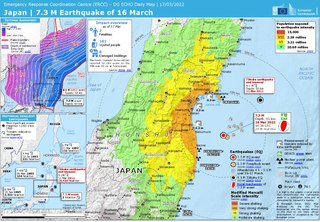
JS Shimokita (LST-4002) is the second ship of the Ōsumi-class tank landing ships of the Japan Maritime Self-Defense Force (JMSDF).

On 11 March 2011, at 14:46 JST, a 9.0–9.1 undersea megathrust earthquake occurred in the Pacific Ocean, 72 km (45 mi) east of the Oshika Peninsula of the Tōhoku region. It lasted approximately six minutes, causing a tsunami. It is sometimes known in Japan as the "Great East Japan Earthquake", among other names. The disaster is often referred to as simply 3.11.

Typhoon Della, known in Japan as the 3rd Miyakojima Typhoon and in the Philippines as Typhoon Maring, was a typhoon that struck Miyakojima of Ryukyu Islands and Kyūshū Island in September 1968.
The following is an overview of the year 2018 in Japan.

Typhoon Georgia was one of the more impactful typhoons that struck Japan, as well as one of the few observed tropical cyclones that made direct landfall in Russia as a tropical storm. A low pressure system formed in the vicinity of Guam on August 10 which formed Tropical Depression Fran, and a new low-level center formed from a fracture of a trough that split newly formed tropical depression in the midnight of August 12. The newly formed low level center was classified as a tropical storm and was named Georgia hours later by the Joint Typhoon Warning Center. The new tropical storm was tracked by Japan Meteorological Agency shortly afterwards and Georgia rapidly intensified into a typhoon. On the next day, Georgia further intensified after passing Chichi Jima and reached peak sustained winds of 110 knots (57 m/s) while quickly accelerating in the north-northwest direction before striking Chūbu region in Japan on evening of the same day as a weakening typhoon. After emerging on the Sea of Japan as a tropical storm on August 14, Georgia made landfall in Soviet Union as a tropical storm at the afternoon of the same day, before transforming into an extratropical storm quickly after landfall. Remnants of Georgia was last noted on Heilongjiang, China on August 16.

Typhoon Bualoi was a powerful typhoon that caused damage across the coast of Japan. The fortieth tropical depression, and the eleventh typhoon of the 2019 Pacific typhoon season, Bualoi originated from a disturbance east of the Marshall Islands on October 17, 2019, that quickly organized to a tropical depression on October 19, given the designated name 22W. Favorable conditions strengthened the depression into a tropical storm and received the name Bualoi. Bualoi rapidly intensified and became a typhoon on October 20. The typhoon's rate of strengthening was stopped by a tropical upper tropospheric trough the following day, but was later recommence through rapid intensification, making Bualoi reach its peak on October 22 as a Category 5-equivalent typhoon, with 10-minute sustained winds of 185 km/h (115 mph) and one-minute sustained winds of 260 km/h (160 mph). Bualoi rapidly weakened on October 23 due to wind shear and continued before transitioning into an extratropical cyclone and dissipating on October 25.

Typhoon Talim, known in the Philippines as Typhoon Lannie, was an intense and destructive tropical cyclone that affected parts of East Asia, especially Japan, during September 2017. The eighteenth named storm and the sixth typhoon of the 2017 Pacific typhoon season, Talim's origins can be traced back to an area of low-pressure that the Joint Typhoon Warning Center first monitored on September 6. The disturbance was upgraded to a tropical depression by the Japan Meteorological Agency only two days later, and it became a tropical storm on September 9, earning the name Talim. Talim grew stronger over the next few days, eventually becoming a typhoon the next day. Within a favorable environment, the typhoon rapidly intensified after passing through the Ryukyu Islands. However, as it moved eastward, Talim started to weaken due to wind shear, and on September 16, it was downgraded to a tropical storm. The storm passed over Japan, near Kyushu the next day, before becoming extratropical on September 18. The extratropical remnants were last noted by the JMA four days later, before dissipating fully on September 22.

On March 20, 2021 at 18:09 JST. The magnitude 6.9 or 7.0 earthquake struck offshore east of Tōhoku, Japan at a depth of 54.0 kilometers (33.6 mi) to 60 kilometers (37 mi). It had a maximum JMA intensity of Shindo 5+ while on the Mercalli intensity scale, it earned a rating of VII. Power outages and some slight damage in Miyagi was reported.

Typhoon Gilda, known in the Philippines as Typhoon Deling was a destructive, deadly, costly and long-lived tropical cyclone that left over 145 confirmed deaths over Japan and South Korea, mostly due to torrential rainfall that induced landslides, all generated by the typhoon and its associated meiyu front. The eighth named storm and third typhoon of the 1974 Pacific typhoon season, the system was first noted by the China Meteorological Agency as an area of convection embedded on a trough, to the north of Enewetak Atoll on June 25. It was named Gilda on June 30 as it strengthened to a tropical storm. Under a favorable environment, it strengthened to a typhoon two days later as it moved northwestward. Another trough pulled Gilda poleward while changing less in intensity, until it intensified to a Category 2 typhoon as it battered the Ryukyu Islands at its peak. Increasing wind shear gradually weakened the system; however, it remained as a minimal typhoon until it passed through the southern tip of South Korea on July 6, where it weakened to a tropical storm. Colder waters in the Sea of Japan and high shear further degraded Gilda, until it transitioned to an extratropical low as it made landfall near Hokkaido on July 9. The remnants of the system briefly intensified near the Kuril Islands before weakening and dissipating on July 17 over the Sea of Okhotsk.

The 2011 Nagano earthquake was an earthquake that occurred near the border between Niigata and Nagano prefectures at 3:59 JST on March 12, 2011. The depth of the hypocenter was 8 km and magnitude of the earthquake was 6.7.

South Kantō earthquakes or Greater Tokyo Area earthquakes are general terms for major earthquakes that occurs repeatedly historically in the southern part of Kanto region in Japan. It has been announced that there is a 70% chance that earthquakes of about M7 will occur in the southern part of the Kanto region within the next 30 years.

The 1982 Nagasaki flood was caused by a cloudburst that occurred mainly in Nagasaki, Japan in July 1982.
The 1978 Izu Ōshima earthquake is an earthquake that occurred on January 14, 1978 at 12:24 local time. The earthquake had a magnitude of 7.0, and the epicenter was located in offshore Izu Ōshima, Japan.
The 1896 Rikuu earthquake is an inland earthquake that occurred on August 31, 1896, near the border between Akita and Iwate prefectures, Japan. Magnitude was 7.2. The earthquake left 209 people dead and 779 people injured. Senya Fault is a fault which was responsible for 1896 Rikuu earthquake, along with surface rupture.
The 1961 Kita Mino earthquake is an earthquake that occurred on August 19, 1961, near the border between Ishikawa, Fukui and Gifu Prefectures in Japan. The magnitude was 7.0. The earthquake left 8 people dead and 43 people injured.
The 1953 Wakayama flood was caused by heavy rain that resulted in landslides and flooding in the Kii Peninsula, Wakayama Prefecture in Japan in July 1953. Collapse of the dikes occurred along many rivers, which caused flooding. It resulted in the deaths of 713 people and 411 people went missing.

The 2011 Shizuoka earthquake occurred approximately 42 km (26 mi) north-northeast of Shizuoka City at 22:31 JST, 15 March 2011. The magnitude was Mw 6.0 or MJMA 6.4, and the depth was 9 km (5.6 mi). The hypocenter of this earthquake is thought to have been near the presumed location of the magma chamber of Mount Fuji. It may have been a triggered earthquake caused by the Tohoku earthquake, which occurred four days earlier, on 11 March 2011. It was sinistral strike-slip fault earthquake. It had a maximum JMA intensity of Shindo 6+ (Fujinomiya) or VIII (Severe) on the Mercalli intensity scale. The earthquake left 80 people injured, and caused some power outages.

On March 16, 2022, at 23:36 JST, a strong earthquake struck off the coast of Fukushima, Japan. The earthquake had a magnitude of 7.4 according to the Japanese Meteorological Agency (JMA), while the United States Geological Survey (USGS) gave an estimate of 7.3. Immediately after the event a 30‑cm tsunami was reported. The event is known in Japanese as Fukushima-ken Oki Jishin. As a result of this natural disaster, three people died and 247 were injured.
















